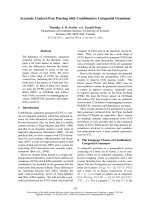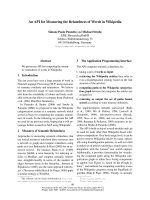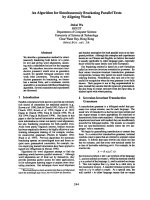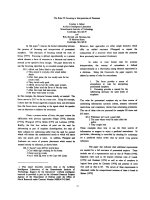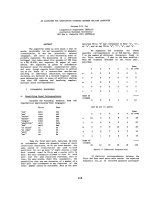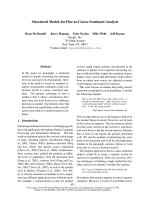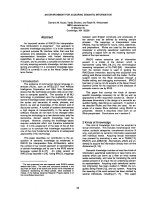Báo cáo khoa học: "AN ALGORITHM FOR GENERATION IN UNIFICATION CATEGORIAL GRAMMAR" pdf
Bạn đang xem bản rút gọn của tài liệu. Xem và tải ngay bản đầy đủ của tài liệu tại đây (612.15 KB, 8 trang )
AN ALGORITHM FOR GENERATION IN UNIFICATION
CATEGORIAL GRAMMAR
Jonathan Calder, Mike Reape and Henk Zeevat
University of Edinburgh
Centre for Cognitive Science
2 Buccleuch Place
Edinburgh
EH8 9LW
Abstract
We present an algorithm for the generation of
sentences from the semantic representations of
Unification Categorial Grammar. We discuss a
variant of Shieber's
semantic monotonicity
requirement and its utility in our algorithm. We
indicate how the algorithm may be extended to other
grammars obeying the same requirement. Appendices
contain a full listing of the program and a trace of
execution of the algorithm.
1. Introduction
In this paper we present an algorithm for
generating sentences using unification categorial
grammars (UCGs, Zeevat et al. 1987) but which
extends to any categorial grammar with unification
(e.g., categorial unification grammars, Uszkoreit
1986, Karttunen 1987). We relate the algorithm to
proposals by Shieber (1988). Following Shieber, we
address the basic generation problem; that is, given a
syntactic category K and a semantic representation ~,
generate every possible string def'med by the grammar
of category K with a semantic representation that is
logically equivalent to ~. In more concrete terms,
this means that we dispense with any planning
component and directly address the intrinsic
complexity of the basic generation problem. The
development of such algorithms is as fundamentally
important as the corresponding work on parsing
algorithms.
We also discuss the properties of a semantic
representation language (SRL) and the manner of its
construction which makes our algorithm effective.
The crucial property is a stricter form of Shieber's
(1988) property of
semantic monotonicity.
We not
only require that the semantics introduced by all
subconstituents of an expression appear within the
semantics of the expression as a whole; we also
require that the semantics of any containing
expression be a further instantiation of one of its
subexpressions.
We introduce the algorithm on a case-by-case
basis, at each stage extending its coverage and include
a listing of the program implementing this
algorithm, as appendix A.
2. Basis of the algorithm
The most important feature of categorial
grammars is the close correspondence of syntactic and
semantic ftmctors. In generation, if the semantic
functor of an expression can be identified, possible
values of the syntactic functor can also be determined.
Under these circumstances, a simple recursive
procedure can be stated which implements a mixed
top-down and bottom-up strategy, alternately
determining the functor of an expression and
generating the arguments to that functor. In the
presentation of the basic algorithm below we will
make the simplifying assumption that for any
formula of the semantic representation language, the
syntactic and semantic functors are immediately
identifiable. We will have to relax this restriction in
order to deal with phenomena such as type raising and
identity semantics.
UCG employs only two types of phrase
structure rules. First, there are two
binary
rules of
forward and backward application. Schematically,
these can be represented as follows.
Result -~ Functor/Active Active
Result ~ Active Functor\Active
The first of the actual rules is stated below.
The second is just like the first except that pre is
substituted for post and the order of the daughters is
reversed. Notice the use of the
order
feature. If a
sign is an argument, then its order value is pre
(post) if it precedes (follows) its functor.
- 233 -
I
phonology: Wf+Wa]
syntax: X
|
semantics: S | "-'>
order: 0 J
- phonology: Wf -
[phonology: Wa]
x, lsY ntax:
Y
/
syntax:
"~'| semantics: Sa [
[.order: post _1
semantics: S
- order: O
phonology: Wa]
syntax: Y
l
semanticsi Sa /
order: post .!
Second, UCG employs a small set of unary rules
of the form a > ~ where a and I~ are UCG signs.
Unary rules have several uses. These include the
treatment of unbounded dependencies, syntactic forms
of type-raising (e.g., generic noun to np rules) and
subcategorization for optional modifiers. In general,
unary rules relate one category to another. In
particular, unary rules can change the category of a
functor. This will require a modification to the basic
strategy we present below.
The language InL (Indexed Language) is a
variant of Kamp's (1981) Discourse Representation
Theory. Its most important properties are i) every
expression has a privileged variable (its
index)
and ii)
every variable is sorted, so indicating the ontological
category of the object denoted by the variable. The
only logical connectives are conjunction and
implication. The semantics of an expression is
constructed compositionally via unification. As
discussed further below, the semantic representation
of any sentence in UCG is simply a further
instantiation of the semantics associated lexically
with one element of the sentence.
3. A sketch of the algorithm
Below we present the basic algorithm which
implements the informal description given above. We
give the algorithm in Prolog for convenience because
various refinements to the algorithm to be discussed
below (e.g., the use of a chart) depend directly on the
procedural aspects of Prolog's control strategy. This
basic version of the algorithm requires that UCG
signs be encoded as first order terms and that term
unification is used. This includes both InL formulas
and sorted indices. A graph encoding of signs and
graph unification could be used but this would make
the presentation of the basic ideas more complicated.
Unary rules are not covered in~ this first
approximation.
generate (Sign) :-
path__value (semantics, Sign, InL),
path value (semant ics, SignO, InL),
lexical (SignO),
reduce (SignO, Sign) .
reduce (Sign, Sign) .
reduce (Sign0, Sign) :-
path value (syntax: active, Sign0,
Active) ,
apply ( Sign0, Active, Result ),
generate (Active),
reduce (Result, Sign) .
The predicate
path_value(Path,Sign,Value)
succeeds if the value of the path
Path
through the
sign
Sign
is
Value. lexicai(Sign)
succeeds if the
sign
Sign
can be unified with a lexical entry.
apply(FunctorActive,ResulO
implements the rules
of forward and backward functional application as
discussed above.
generate(Sign)
generates a sign
Sign
with
phonology ~, syntactic category K and semantics
Z
by creating a new sign
SignO
with phonology ~',
syntactic category K' and semantics Z, unifying the
sign with a lexical entry and then
reducing SignO to
Sign
in a bottom-up fashion. Thus
generate
implements the top-down half of the control strategy
by "predicting" the syntactic category of
Sign
on the
basis of which lexical entries unify with it. The
bottom-up reduction is necessary as it is not
necessarily the case that • = ~' or that K = K'. In
particular, unless ~. corresponds to a nonfunctor
lexical entry,
SignO
will be of the schematic form
X/Y (i.e., a lexical functor).
reduce has two clauses. The first reduces a
sign
Sign
to itself. The second reduces a sign
SignO
to a sign Sign if Sign0 is a functor
Functor/Active which when applied to Active by
one of the rules of functional application gives the
result sign Result, the sign Active can be
generated and Result can be reduced to
Sign. A
sample execution of the algorithm, using only the
above clauses for the two predicates, is given in
Appendix B.
There is a major deficiency in this algorithm.
Unification is the only method used to test the
logical equivalence of two semantic representations.
This means that not even the axioms of
commutativity or associativity are available for
testing logical equivalence 1. One of the
1Strictly speaking, we test for a very strict form
of consistency. Two LFs are considered logically
- 234-
consequences of this is that, given a semantic
representation ~b, it may not be possible to generate a
sentence with semantic representation 0', where ~ and
0' are logically equivalent. In fact, it may not be
possible to generate any sentence even though there
are sentences defined by the grammar which have
semantic representations which are equivalent to ~b.
So, for example, an semantic representation which is
produced by parsing a nontopicalised sentence cannot
be used to generate a topicalised sentence.
Shieber (1988) claims that the problem of
logical equivalence reduces to the
knowledge
representation problem. The
claim is that there will
be no full solution to this problem in the near future.
To satisfy our definition of generation however, we
must generate all sentences whose semantic
representations are logically equivalent to the
semantic representation being generated under the
rules of inference and axioms of the semantic
representation language. In the case of InL, the
primary axioms are simply associativity and
commutativity. However, these two axioms alone
give the equivalence problem factorial complexity.
We will discuss these issues below after we have
introduced some refinements to the algorithm.
4. Refinements to the basic algorithm
The algorithm presented above is deficient in
other respects. There are three other aspects of UCG
analyses that are not covered. First, all Nl's are
type-
raised. The
standard UCG analysis of non-lexieal NPs
is adequately handled using the above definitions, as
the resulting semantic structure contains information
introduced by the determiner. On the other hand, a
lexical NP such as
Harry
will bind a variable in the
semantics of an expression indicating that the
translation of
Harry
is a constant. However, no
other semantic material will be introduced from
which the need to generate a lexical NP could be
inferred. This is remedied quite easily by adding the
condition, to the second clause of reduce above, that
the category of
SignO
is not
np,
and by adding the
following clause to reduce:
reduce(Sign0, Sign) :-
path_value(category:active,
Sign0, Active),
path_value(category, Active, np),
path_value(semantics, Active,
Index),
proper name(Index),
equivalent if their sorted indices are consistent but the
rest of the formula is logically equivalent. We return
to this point briefly below.
typeraise_np (Active,
TypeRaisedNP ),
apply (TypeRaisedNP, Sign0,
Mother) ,
generate (TypeRaisedNP),
reduce (Mother, Sign) .
The most important part of the above def'mition
is the restriction of the clause to the generation of
elements which satisfy the predicate proper name;
we assume this test to be appropriately defined
according to the semantic representation language
used. In our case, it is a simple test for instantiation.
The predicate
typeraise_np(Active, TypeRaisedNP)
relates a non-type-raised to a type-raised NP. Note
that in the call to generate, we attempt to generate
from the constructed type-raised NP. The reasons for
this are that lexical NPs have to be type-raised prior
to the lexical lookup in generate and that the
argument to the type-raised NP is generated in exactly
the same manner as other arguments.
Two further problems are the treatment of unary
rules and functors with what Shieber (1988) calls
vestigial semantics,
which we prefer to call
identity
semantics. The
latter identify the semantics of their
argument with their own semantics. That is, they are
semantically vacuous. Examples from English are
complementisers and case-marking prepositions.
Again, we add an additional clause to reduce which
enumerates the set of relations that may hold between
signs under unary rules and under functors with
identity semantics, using the auxiliary predicate
transform. The clause re.cursively invokes reduce
as it may be the case that a unary rule or functor
with identity semantics introduces further syntactic
arguments.
reduce (Sign0, Sign) :-
transform(Sign0, Sign1),
reduce (Sign1, Sign) .
transform(Daughter, Mother) :-
unary_rule(Mother, Daughter).
transform(Sign0, Sign) :-
path_value(category:active,
Sign1, Sign0),
identity(Sign1),
apply(Sign1, Sign0, Sign).
identity enumerates those lexical entries
whose semantics is the same as that of one of its
arguments. Note that both of these clauses continue
the basic bottom-up reduction strategy. Essentially,
we must freely apply both identity semantics functors
and unary rules to guarantee completeness of the
algorithm. Given that we apply unary rules and
identity functors freely, our algorithm will only
terminate if the bottom-up closure of such elements
- 235 -
with respect to elements of the lexicon is finite. In
other words, we require that the grammar adhere to
the offline parsability constraint (Kapland and
Bresnan 1982). If this condition does not hold, the
algorithm will not terminate.
5. Optimizations of the algorithm
Given the fairly high degree of top-down
control, it should be obvious that the generator will
generate some subformulas of its input repeatedly as
it explores the search space. The obvious solution is
to use a lemma table or chart (as discussed by Pereira
and Warren 1984 and Shieber 1988). Shieber (1988)
states that to guarantee completeness in using a
precomputed entry in the chart, the entry must
subsume the formula being generated top-down.
However, empirical tests have shown that a naive
chart strategy results in the chart never being used at
all. This is to be expected given the nature of
generation; since most of the signs being generated
top-down are very partial (often they will have only
the semantics instantiated) and chart entries will be
very complete (since most information is projected
from the lexicon) it will almost never be the case that
a top-down sign is subsumed by the chart.
The result is that we must either abandon the
idea of using a chart I or else devise a strategy for its
use which is complete, does not rely on the
subsumption test and does not put too many entries
in the chart We have followed the latter strategy.
This technique depends crucially on avoiding any top-
down instantiation of candidate chart entries and by
guaranteeing bottom-up completeness of chart entries
consistent with a restriction of the top-down sign.
The nature of the restriction that we use depends on
properties of the semantic representation language
itself. In particular, the only use of variables in the
language is in representing existentially quantified
variables over individuals. Thus every appearance of a
variable can only be further instanfiated by a semantic
individual constant and so the semantic representation
after generation cannot be further instantiated in such
a way that the denotation of that expression differs
from that of the input semantic representation.
1A recent implementation of a similar
algorithm by Thierry Guillotin and Agnes Plainfoss6
(Personal communication) suggests that the top-down
application of unary rules, while making it
impossible to guarantee completeness if making use
of a chart, nevertheless leads to an overall
improvement in efficiency by limiting the search
space engendered by unary rules. This supports the
contention that unary rule application is the dominant
cost in generation with UCG.
The program presented in Appendix A
illustrates the use of the chart. The reader will notice
that the instruction to add information to the chart
follows calls to generate but precedes calls to
reduce. This strategy means that we keep the chart
free of the top-down instantiations caused by equating
a bottom-up solution (the first argument of reduce)
to a top-down goal (the second argument of reduce).
Another method for reducing the search space is
to use the technique of freezing in cases where the
premature instantiation of variables will lead to
avoidable backtracking. In the case of our current
UCG grammar, it is often the case that the order
feature is not instantiated when apply is called. If
the argument is generated before the phonology is
instantiated, then unnecessary generations with the
wrong word order can be prevented. Therefore, we
freeze the value of the phonology and order attributes
until after an argument is generated. This requires
some care to ensure that the freezing interacts with
the chart strategy correctly. This is illustrated in the
full program listing below. It is to be expected that
more complex grammars would benefit from an
extension of this technique to other attributes with
mut~j~lly dependent values.
6. Extension to other grammatical
formalisms
We alluded above to our assumption about the
relationship between the semantics of lexical and
non-lexical expressions. To recap, any semantic
representation is a further instantiation of the
semantic representation of some lexical item. This
assumption will not hold for any grammar in which
semantic material is introduced by rule (i.e.
syncategorematically). The reason for this should be
obvious given the definition of generate above. If a
particular semantic representation possibly contains
semantic structure not present in the lexicon, then
any attempt to find an appropriate lexical functor on
the basis of the semantics of an expression is not
guaranteed to succeed. Relaxing this assumption
would effectively remove all top-down predictive
capacity for generation. The only solution in the
context of this algorithm would then be to allow top-
down application of all rules and to delay calls to
lexical lookup until after rule application. This
generate and test strategy is not only likely to be
inefficient, it will also result in non-termination for
many grammars.
In contrast, for grammars which do adhere to
our assumption, our algorithm is effective, even if
rules other than simple binary and unary rules are
used. To see this, consider the following extension to
reduce:
- 236 -
reduce(SignO, Sign)
rule(Morn,
SignO, Kids),
generate_sisters (Kids) ,
reduce (Morn, Sign) .
Note that this clause is very similar in
structure to the second clause for reduce, the main
difference being that the new clause makes fewer
assumptions about the feature structures being
manipulated, rule enumerates rules of the grammar,
its first argument representing the mother
constituent, its second the head daughter and its third
a list of non-head daughters which are to be
recursively generated by the predicate
generate_sisters.
(We assume, as with UCG, that
information indicating the resulting phonology and
order of constituents is contained within the feature
structures of the rule). The behaviour of this clause is
just like that of the clause for reduce which
implements the UCG rules of function application.
On the basis of the generated lexical sign
SignO an
application of the rule is hypothesised and we then
attempt to prove that that rule application will lead to
a new sign
Morn
which reduces to the original goal
Sign.
The same conditions apply
to
the generalized
form of the predicate as
to
the clause for unary rules,
namely the algorithm will terminate if the bottom-up
closure of the rules of the grammar is finite. We
conjecture that this algorithm extends naturally to the
rules of composition, division and permutation of
Combinatory Categorial Grammar (Steedman 1987)
and the Lambek calculus (1958).
7. Implementation
The algorithm discussed in this paper has been
implemented in C-Prolog. Recent work has looked at
generation from semantic representations which are
not in canonical format but which are equivalent,
under the axioms of associativity and commutativity
to the canonical semantics of sentences recognised by
the grammar. Our effort is directed at formulating
appropriate notions of "semicanonicality", which
lessen the strict (and in many cases unobtainable)
requirement that the representation to be generated
from is identical to that obtained as the result of
parsing. Such notions would increase the utility of
generators such as we have presented while avoiding
the dangers of factorial complexity.
A further source of inefficiency is the naive
lexical indexing strategy used by the predicate
lexical. We have presented the algorithm as if
iexical simply enumerates the lexicon. This is
clearly inefficient and some form of indexing strategy
seems essential. The simplest is to choose the
principal functor of the semantic representation to use
as the index for lexical entries which have the same
principal functor in their semantics. Much of the
time however, the principal functor is simply the
conjunction operator. A more sophisticated indexing
strategy involves calculating the best (set of) key(s)
to identify candidate lexical entries. This necessarily
involves considerable complexity itself.
Furthermore, if such indexing is to be automatic,
very sophisticated compilation techniques and
metaknowledge about the possible structure of
semantic representations are required. We are also
investigating these possibilities.
Acknowledgements
The work reported here is supported by ESPRIT
project P393 ACORD: The Construction and
Interroagtion of Knowledge Bases using Natural
Language text and Graphics. Thanks are due to
Philippe Alcouffe, Lee Fedder, Thierry Guillotin,
Dieter Kohl and Agnes Plainfoss6 for discussions of
problems in generation with UCG. All errors are of
COurSO Our OWrl.
References
Kaplan R M. and Bresnan J. (1982) Lexical-
Functional Grammar: a formal system for
grammatical representation, Chapter 4 in J.
Bresnan (ed.)
The Mental Representation of
Grammatical Relations,
173-281, MIT Press,
Cambridge Mass.
Karttunen, L. (1986) Radical Lexicalism. Report
No. CSLI-86-68, Center for the Study of
Language and Information, December, 1986.
Paper presented at the Conference on Alternative
Conceptions of Phrase Structure, July 1986,
New York.
Lambek, J. (1958) The mathematics of sentence
structure.
American Mathematical Monthly,
65, 154-170.
Pereira, F. C. and Warren, D. H. (1983) Parsing as
Deduction. In
Proceedings of the 21st Annual
Meeting of the Association for Computational
Linguistics,
Massachusetts Institute of
Technology, Cambridge, Mass., June, 1983,
137-144.
Shieber, S. (1988) A Uniform Architecture for
Parsing and Generation. In
Proceedings of the
12th International Conference on
Computational Linguistics,
Budapest, 22-27
August, 1988, 614-619.
Steedman, M. J. (1987) Combinatory Grammars and
Parasitic Gaps.
Natural Language and
Linguistic Theory, 5,
403-439.
- 237-
Uszkoreit, H. (1986) Categorial Unification
Grammars. In
Proceedings of the 11th
International Conference on Computational
Linguistics and the 24th Annual Meeting of the
Association for Computatinoal Linguistics,
Institut fur Kommunikationsforschung und
Phonetik, Bonn University, Bonn, 25-29
August, 1986, 187-194.
Zeevat H., Klein, E. and Calder, J. (1987) An
Introduction to Unification Categorial
Grammar. In Haddock, N.J., Klein, E. and
Morril, G. (eds.)
Edinburgh Working Papers in
Cognitive Science,
Volume 1:
Categorial
Grammar, Unification Grammar and Parsing.
Appendix A: program listing
This listing contains all code discussed in the
text for generation with UCG and includes a correct
treatment of the chart. The second argument to
generate is not discussed above: its function is
simply to disable the check that determines whether
to add information to the chart when that information
has just been retrieved from the chart.
/* generate/2 */
generate(Sign, chart) :-
verify(unifies with chart(Sign)),
unifies_with_chart(Sign).
generate(Sign, nonchart) :-
path_value(semantics, Sign, Sem),
path value(semantics, Sign0, Sem),
lexicon(Sign0),
reduce(Sign0, Sign).
!,
/* reduce/2 */
reduce(Sign, Sign).
reduce(Sign0, Sign) :-
path_value(category:active, Sign0,
Active),
path value(category, Active, np),
path_value(semantics, Active, Index),
proper_name(Index),
typeraise_np(Active, TypeRaisedNP),
apply(TypeRaisedNP, Sign0, Mother, [],
Freezer),
generate(TypeRaisedNP, Chart),
unfreeze(Freezer, I]),
add to chart(TypeRaisedNP, Chart),
reduce(Mother, Sign).
reduce(Sign0, Sign) :-
path value(category:active, Sign0,
Active),
pathvalue(category, Active, Category),
not Category =np, not Category = pp,
apply(Sign0, Active, Mother, [],
Freezer),
generate(Active, Chart),
unfreeze(Freezer,[]),
add to chart(Active, Chart),
reduce(Mother, Sign).
reduce(Sign0, Sign) :-
transform(Sign0, Signl, [], Freezer),
unfreeze(Freezer,[]),
add to chart(Signl, nonchart),
reduce(Signl, Sign).
/*transform/4 */
transform(Daughter, Mother, Freezer,
Freezer) :-
unary_rule(Mother, [Daughter]).
transform(Sign0, Sign, Freezer0, Freezer)
:-
path_value(category:active, Signl,
Sign0),
identity(Signl),
apply(Signl, Sign0, Sign, Freezer0,
Freezer).
/* apply/5 */
apply(Sl, S2, S3, F0,
[freeze(Order2,Phonology,WI,W2) IF0]) :-
Sl = sign(Wi,Catl/S2,Seml,Order),
$2 = sign(W2,Cat2, Sem2,Order2),
S3 = sign(Phonology,Catl,Seml,Order).
/* typeraise_np/2 */
typeraise_np(Sign0,Sign) :-
Sign0 = sign(_,np,_,_),
Sign = sign( ,Cat/
sign(_,Cat/
sign( Order),
Sem0, Order),
Sem,_),
Sign = sign( ,
/sign( , /Sign0, , ),
~, ) •
/* proper_name/l */
proper_name(N) :- nonvar(N) .
/* unifies with chart/l */
unifies with chart(S) :-
chart(S).
/* add to chart/2 */
add to chart(S, nonchart) :-
verify(unifies_with_chart(S)),
add to chart(S, nonchart) :-
assertz(chart(S)).
add to chart(_, chart).
! .
- 238 -
/*
unfreeze/2
*/
unfreeze([], []).
unfreeze([freeze(pre,Wl+W2,WI,W2) IR],F) :-
unfreeze(R,F).
unfreezer([freeze(post,W2+Wi,WI,W2) [R],F) :-
unfreeze(R,F).
/*
verify/l
*/
verify(Goal) :-
\+
\+(Goal).
Appendix B: A trace of program execution
In this example, wc use only the first two
clauses of reduce/2 above. Figure 1 gives a
graphical representation of the information flow
during generation, reduce(I) indicates a use of the
first, base clause, and reduce(2) a use of the second.
Circled numbers in the figure refer to the subsequent
attribute value structures. We omit (8) and (13) as the
corresponding feature structures are easily determined
by inspection, corresponding to the base clause of
reduce/2.
Active
lexicon
Mother
generate
lexicon
Active
reduce
generate
(1)
lexicon
reduce (1)
O:0uG
Figure
1: A
trace of execution for the sentence
Every boy dreams
rphon:
w -]
[cat: sent [
(1) [sem: s:lmp:[m:boy:[],e:dream:[m]][
Lorder: Order .I
- 239 -
['phon: W ]
|eat: Cat
(2) [sere:
s:imp:[m:boy:[],e:dream:[m]]
Lorder: Order
(3)
vP
hon: every
VPhon: Wf q
/
r ph°n: Wall
eat: np
[eat: Cat'Cat: Cat~ sem:m ///X
I
/
Lorder:
o,,/
J lsem: e:dream:tm] l
I
I-order: Oa _1
|sere: s:lmp:[m:boy:[],e:dream:[m]]
' order: Of
rphon: Wn
1
/eat:
noun
/
where X =
|sem: m:boy:[]l
Lorder: pre 3
rphon: Wn
1
leat: noun [
(4) [sere: m:boy:[] /
Lorder: pre l
(5)
vP
hon: every+Wn 1
FPhon: Wf q
/
r ph°n:
Well
cat: np
lcat: CatJeat: Cat sem: m //
I 1 L°rder: Oa// ' J
I /sere: e:dre.m:l:m] /
I I-order: Oa -J
sem: s:lmp: [re:boy: [],e:dream: [m]]
order: Of
[-phon: Wn
]
/eat: Cat
I
(6) isem: re:boy:ill
Lorder: Order 3
rphon: boy
]
/cat: noun l
(7)/sem:
m:boy:[]/
Lorder: Order 3
(9)
I
phon: Wf 3
FP h°n:
wq/
lcat: np //
cat: Catlsem" m l|
I.order: Oa/]
sere:
e:dream:[m] |
order: Oa .J
rphon: every+boy+Wf "1
|cat: Cat
J
(10) |sere:
s:|mp:[m:boy:[],e:dream:[m]][
Lorder: Of _1
Fphon: Wf "1
|cat: Cat |
(11) |sere: e:dream:[m] I
Lorder: Oa .J
FPhon: dreams q
| r phOn: Wal|
[
Jcat: np /[
o2)
l°'t:
sentqsem:
in
l/
J
Lorder:
preJJ
lsem:
e:dream:[In] |
l-order: Oa _l
rPhon: every+boy+dreams l
/cat:
sent l
(14)/sere: s:imp:[m:boy:[],e:dream:[m]] /
Lorder: Of
3
- 240 -
